Math Writing Questions Test 1
Which choice best maintains the sentence pattern already established in the paragraph?
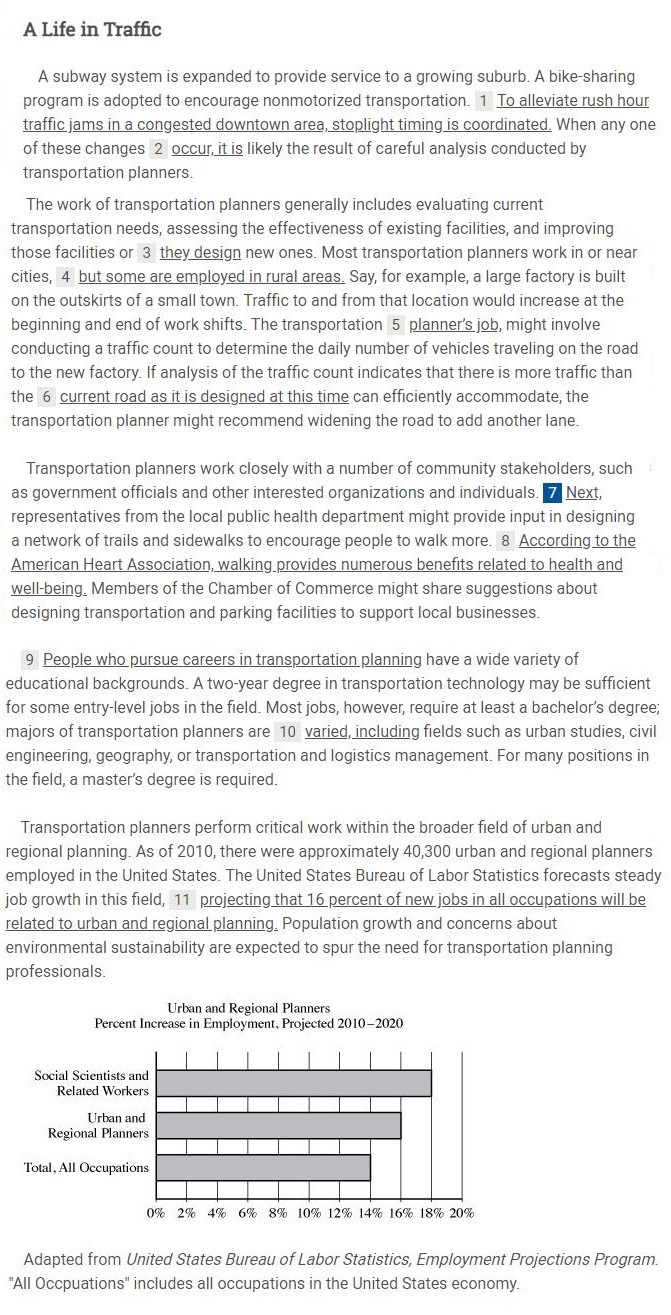
Choice B is the best answer because the transitional phrase “For instance” logically indicates that what follows provides an example related to the previous sentence. “Representatives from the local public health department” is an example of the kinds of people with whom transportation planners work. Choice A is not the best answer because the transitional word “Next” indicates sequence, which is not logical given that what follows provides an example related to the previous sentence. Choice C is not the best answer because the transitional word “Furthermore” indicates addition, which is not logical given that what follows provides an example related to the previous sentence. Choice D is not the best answer because the transitional word “Similarly” indicates comparison or likeness, which is not logical given that what follows provides an example related to the previous sentence.
Which choice best maintains the sentence pattern already established in the paragraph?
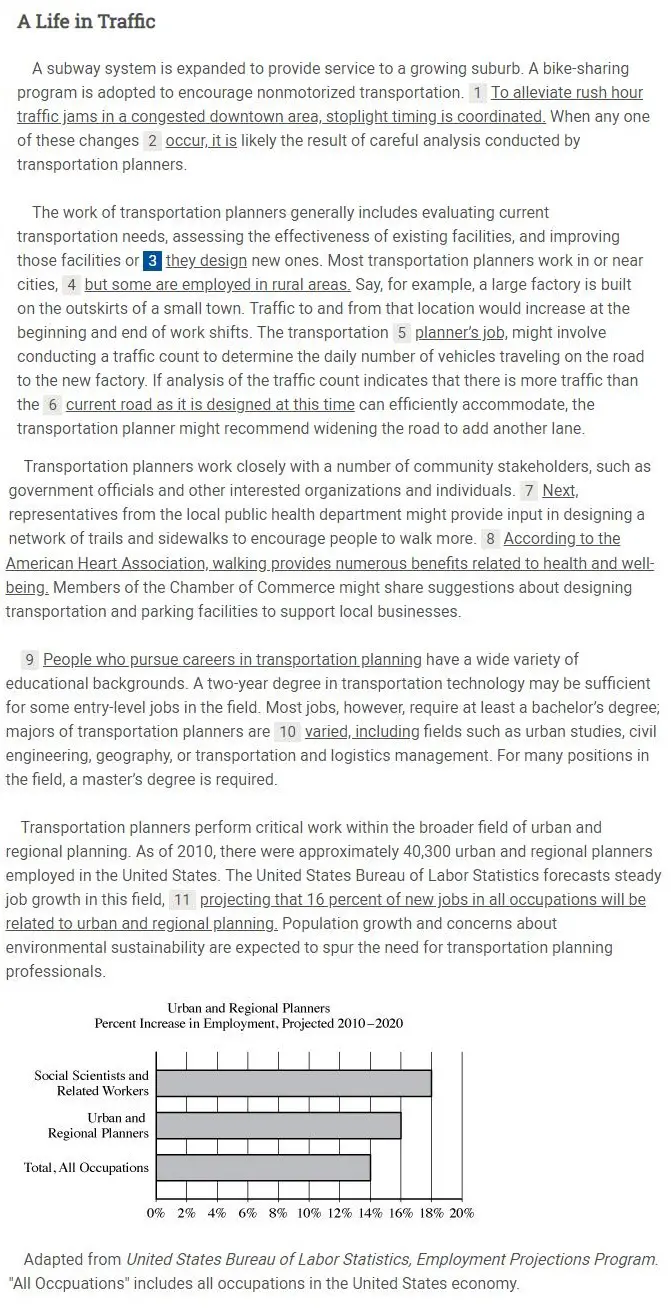
Choice C is the best answer because “designing” maintains parallelism with “evaluating,” “assessing,” and “improving.” Choice A is not the best answer because “they design” does not maintain parallelism with “evaluating,” “assessing,” and “improving.” Choice B is not the best answer because “to design” does not maintain parallelism with “evaluating,” “assessing,” and “improving.” Choice D is not the best answer because “design” does not maintain parallelism with “evaluating,” “assessing,” and “improving.” Choice A is not the best answer because the plural verb “occur” does not agree with the singular subject “any one.” Choice B is not the best answer because the plural verb “occur” does not agree with the singular subject “any one” and because the plural pronoun “they” does not agree with the singular antecedent “any one.” Choice C is not the best answer because the plural pronoun “they” does not agree with the singular antecedent “any one.”
Which choice best maintains the sentence pattern already established in the paragraph?

Choice C is the best answer because it most closely maintains the sentence pattern established by the two preceding sentences, which begin with a noun and passive verb phrase (“A subway system is expanded,” “A bike-sharing program is adopted”). Choice A is not the best answer because it does not maintain the sentence pattern established by the two preceding sentences. Rather, it begins the sentence with an infinitive phrase. Choice B is not the best answer because it does not maintain the sentence pattern established by the two preceding sentences. Rather, it begins the sentence with a gerund. Choice D is not the best answer because it does not maintain the sentence pattern established by the two preceding sentences. Rather, it shifts the placement of a modifying prepositional phrase, “in a congested downtown area,” from the end of the sentence to the beginning of the sentence.
Which choice best maintains the sentence pattern already established in the paragraph?
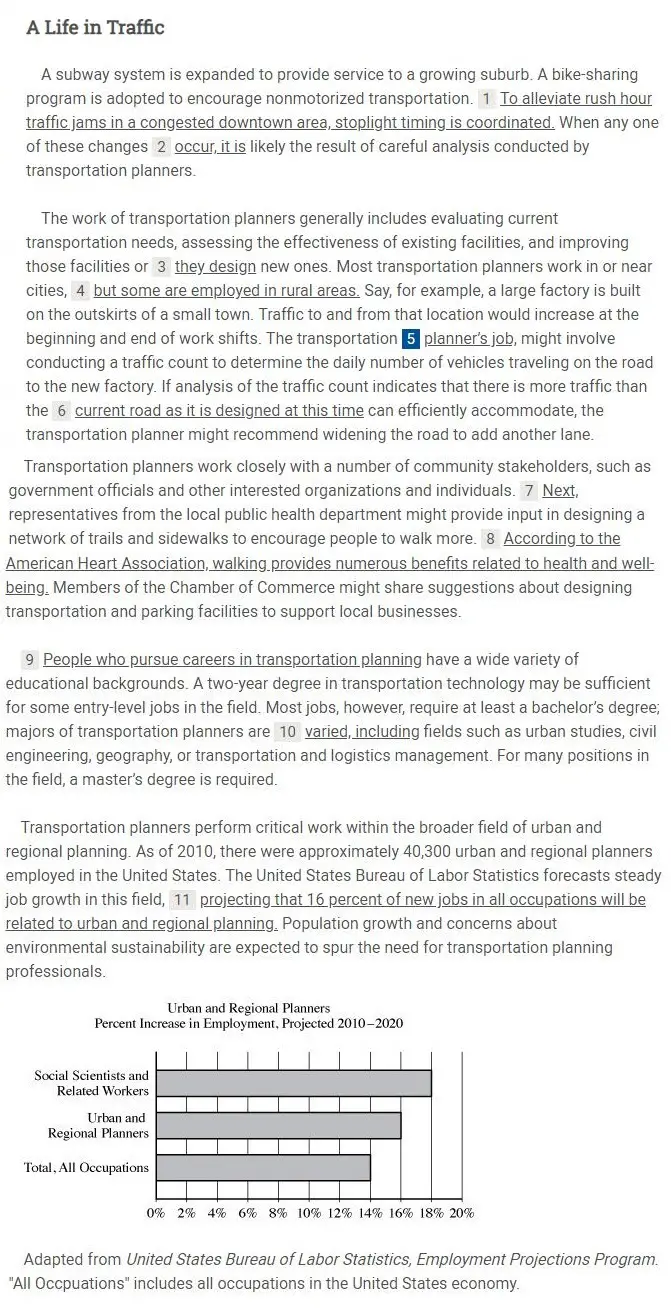
Choice B is the best answer because it correctly uses an apostrophe to indicate the possessive and doesn’t introduce any unnecessary punctuation. Choice A is not the best answer because, while it correctly indicates the possessive relationship between “transportation planner” and “job,” it introduces an unnecessary comma after the word “job.” Choice C is not the best answer because it doesn’t indicate the possessive relationship between “transportation planner” and “job,” and it introduces an unnecessary comma after the word “job.” Choice D is not the best answer because it doesn’t indicate the possessive relationship between “transportation planner” and “job.”
Which choice completes the sentence with accurate data based on the graph?
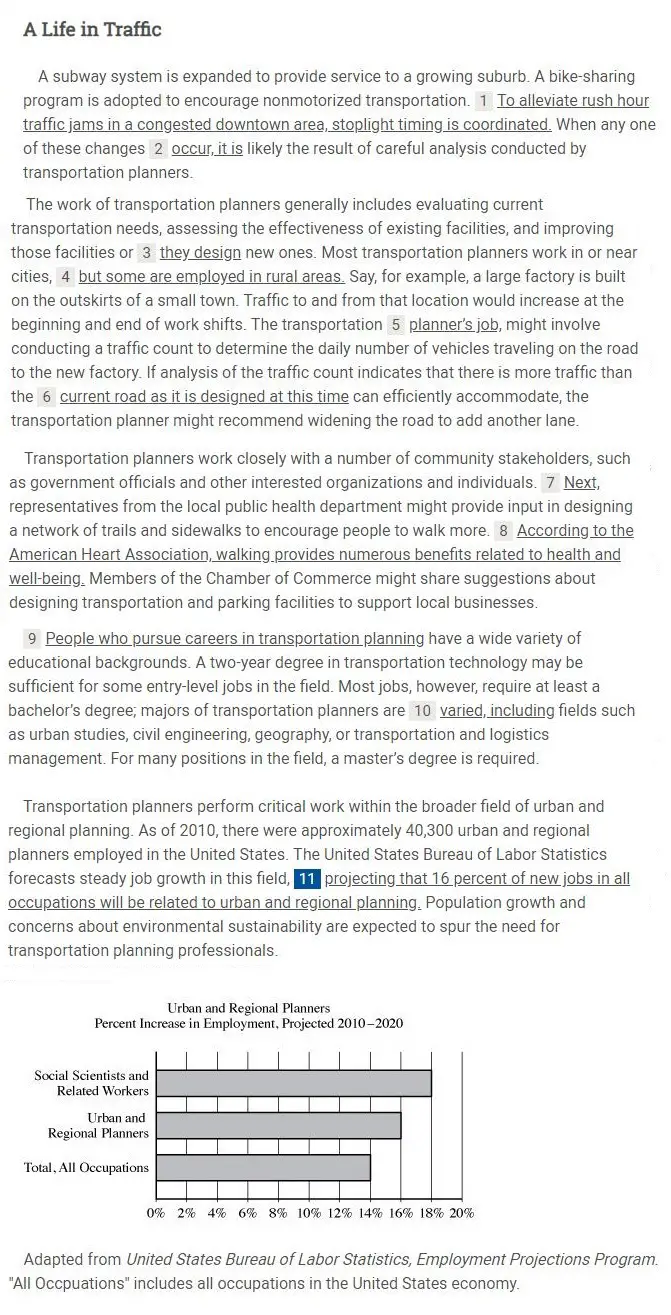
Choice C is the best answer because it completes the sentence with an accurate interpretation of data in the graph. The graph displays projections of how much growth in employment there is expected to be between 2010 and 2020 for “social scientists and related workers,”for “urban and regional planners,” and in “all occupations” in the U.S. economy. According to the graph, the employment of urban and regional planners is expected to increase 16 percent between 2010 and 2020. Choice A is not the best answer because the data in the graph do not support the claim that 16 percent of new jobs in all occupations will be related to urban and regional planning. Choice B is not the best answer because the data in the graph do not support the claim that job growth in urban and regional planning will slow to 14 percent by 2020. Choice D is not the best answer because the data in the graph do not support the claim that 14 to 18 percent of urban and regional planning positions will remain unfilled.
The writer is considering deleting the underlined sentence. Should the sentence be kept or deleted?
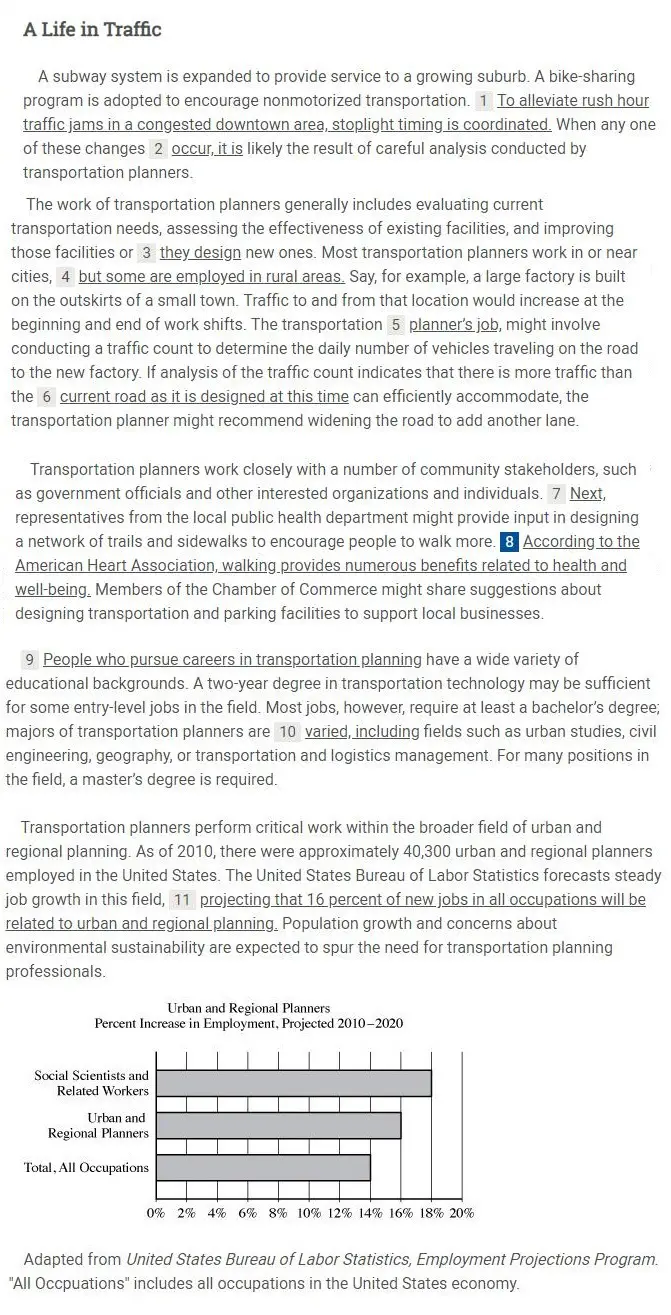
Choice C is the best answer because it identifies the best reason the underlined sentence should not be kept. At this point in the passage and paragraph, a general statement about the benefits of walking only serves to interrupt the discussion of the community stakeholders with whom transportation planners work. Choice A is not the best answer because the underlined sentence should not be kept. Although the sentence could theoretically provide supporting evidence about the benefits of walking, the passage has not made a claim that needs to be supported in this way, and including such a statement only serves to interrupt the discussion of the community stakeholders with whom transportation planners work. Choice B is not the best answer because the underlined sentence should not be kept. Although the American Heart Association could theoretically be an example of “other interested organizations” that transportation planners work with, the sentence does not suggest this is the case. Instead, the association is merely the source for the general statement about the benefits of walking, a statement that only serves to interrupt the discussion of the actual community stakeholders with whom transportation planners work. Choice D is not the best answer because although the underlined sentence should be deleted, it is not because the sentence lacks specific examples of the numerous benefits of walking. Adding such examples would only serve to blur the focus of the paragraph further with general factual information, as the paragraph’s main purpose is to discuss the community stakeholders with whom transportation planners work.
Which choice best maintains the sentence pattern already established in the paragraph?
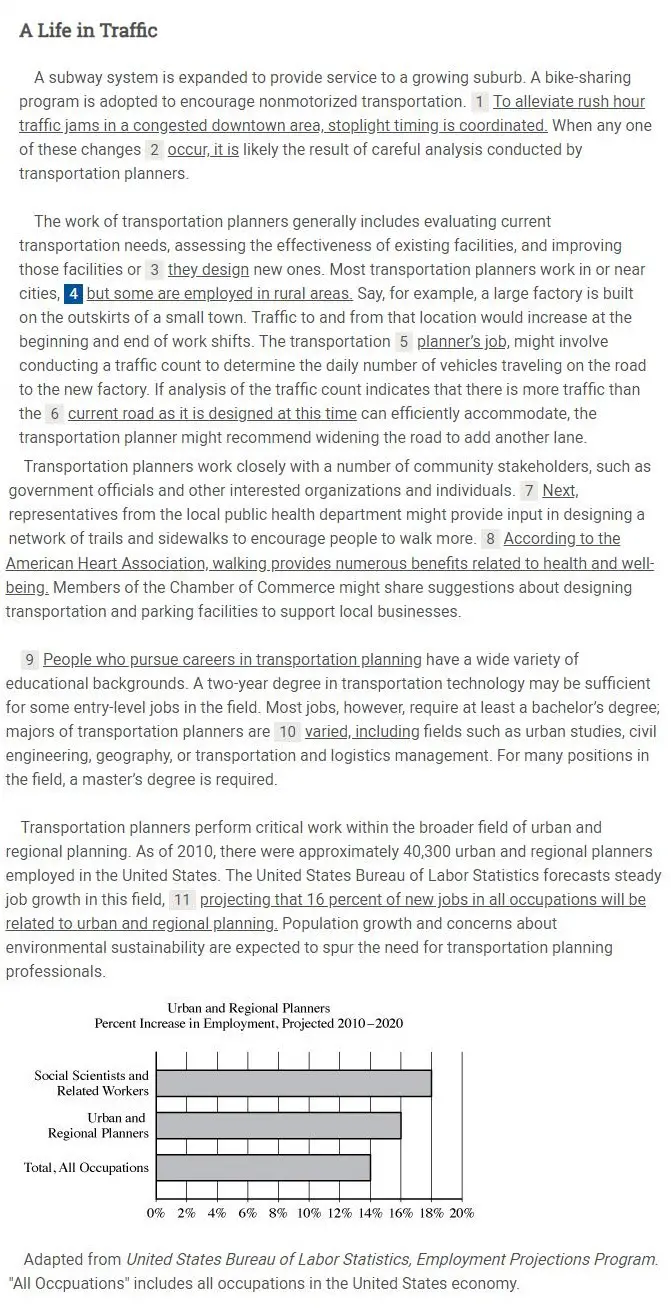
Choice A is the best answer because it effectively signals the shift in the paragraph to the example of the work a transportation planner might perform if he or she were employed in a rural area and asked to consider the effects of building a new factory “on the outskirts of a small town.” Choice B is not the best answer because noting that job opportunities are more plentiful in cities does not effectively signal the shift in the paragraph to the example of the work a transportation planner might perform if he or she were employed in a rural area. Choice C is not the best answer because noting that most transportation planners work for government agencies does not effectively signal the shift in the paragraph to the example of the work a transportation planner might perform if he or she were employed in a rural area. Choice D is not the best answer because the proposed deletion would create a jarring shift from the statement “Most transportation planners work in or near cities” to the example of the work a transportation planner might perform if he or she were employed in a rural area.
Which choice best maintains the sentence pattern already established in the paragraph?
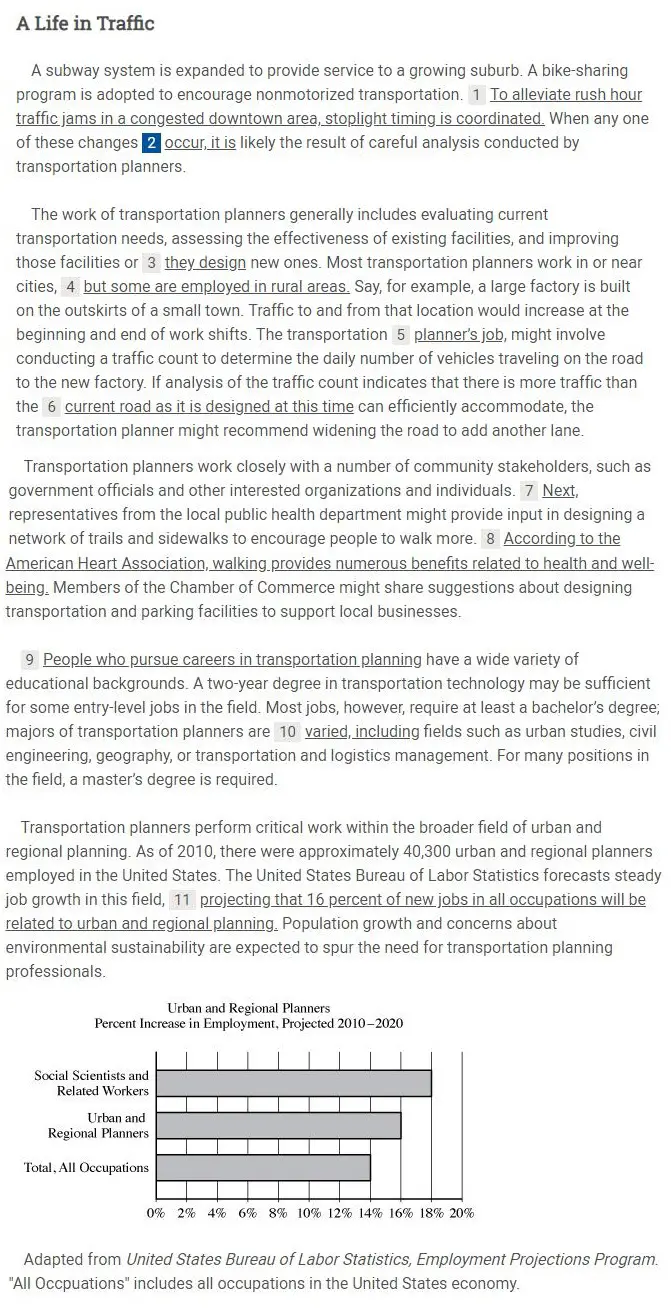
Choice D is the best answer because it maintains agreement between pronoun (“it”) and antecedent (“any one”) and between subject (“any one”) and verb (“occurs”). Choice A is not the best answer because the plural verb “occur” does not agree with the singular subject “any one.” Choice B is not the best answer because the plural verb “occur” does not agree with the singular subject “any one” and because the plural pronoun “they” does not agree with the singular antecedent “any one.” Choice C is not the best answer because the plural pronoun “they” does not agree with the singular antecedent “any one.”
Which choice best maintains the sentence pattern already established in the paragraph?
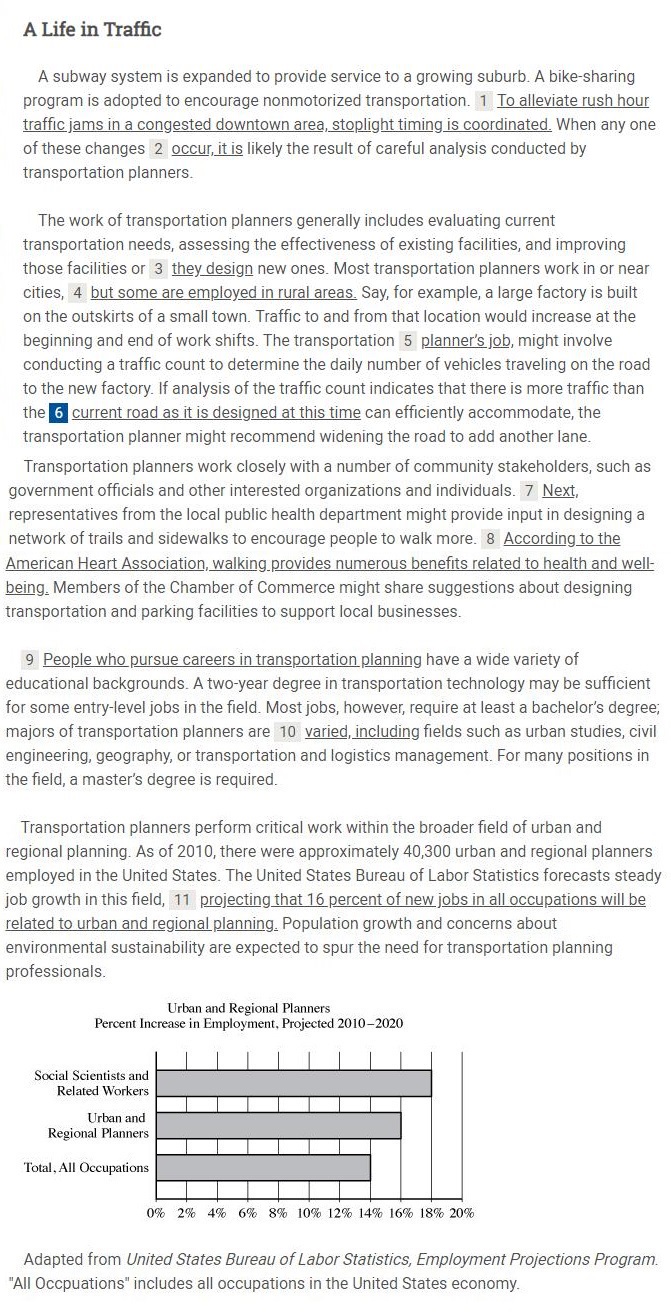
Choice D is the best answer because it offers a clear and concise wording without redundancy. Choice A is not the best answer because “current” is redundant with “at this time.” Choice B is not the best answer because “current” is redundant with “right now.” Choice C is not the best answer because “now” is redundant with “currently.”
Which choice best maintains the sentence pattern already established in the paragraph?
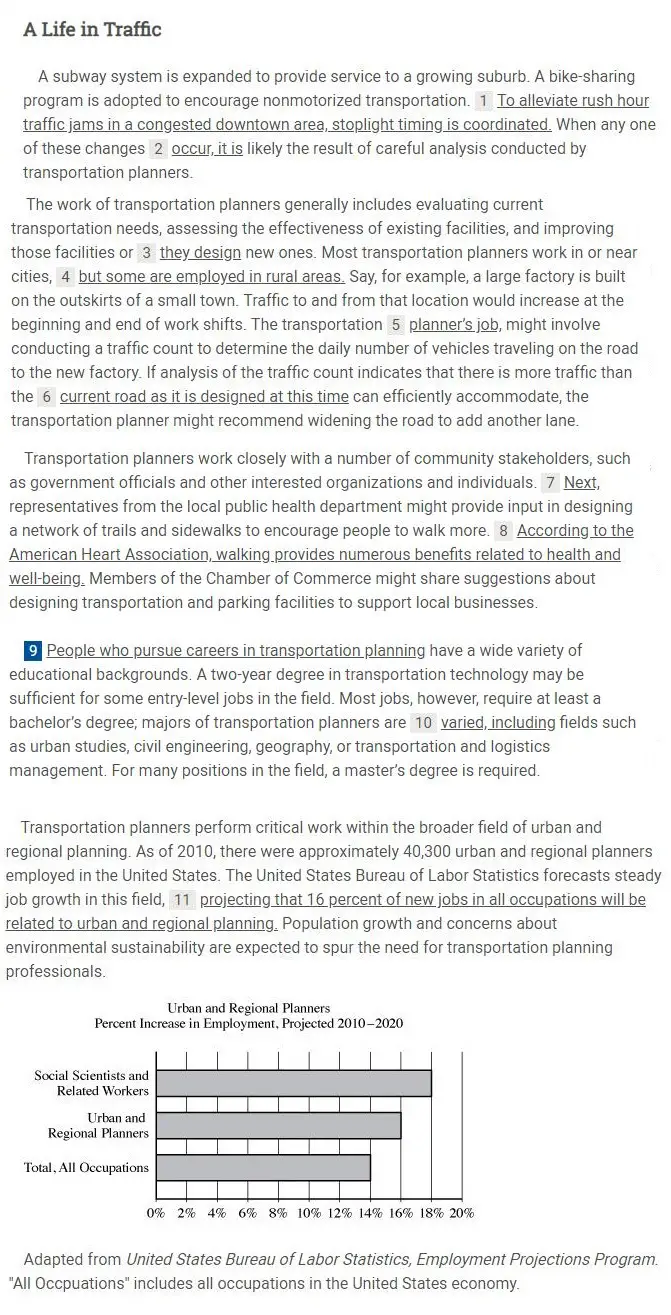
Choice A is the best answer because “who pursue careers in transportation planning” is, in context, a restrictive clause that should not be set off with punctuation. “Who pursue careers in transportation planning” is essential information defining who the “people” are. Choice B is not the best answer because it incorrectly sets off the restrictive clause “who pursue careers in transportation planning” with commas as though the clause were nonrestrictive, or not essential to defining who the “people” are. Choice C is not the best answer because it incorrectly sets off the essential sentence element “in transportation planning” with commas as though the phrase were not essential to the meaning of the sentence. “In transportation planning” is essential information defining what the “careers” are. Choice D is not the best answer because it introduces an unnecessary comma after the word “planning,” incorrectly setting off the subject of the sentence (“people who pursue careers in transportation planning”) from the predicate (“have a wide variety of educational backgrounds”).
Which choice best maintains the sentence pattern already established in the paragraph?
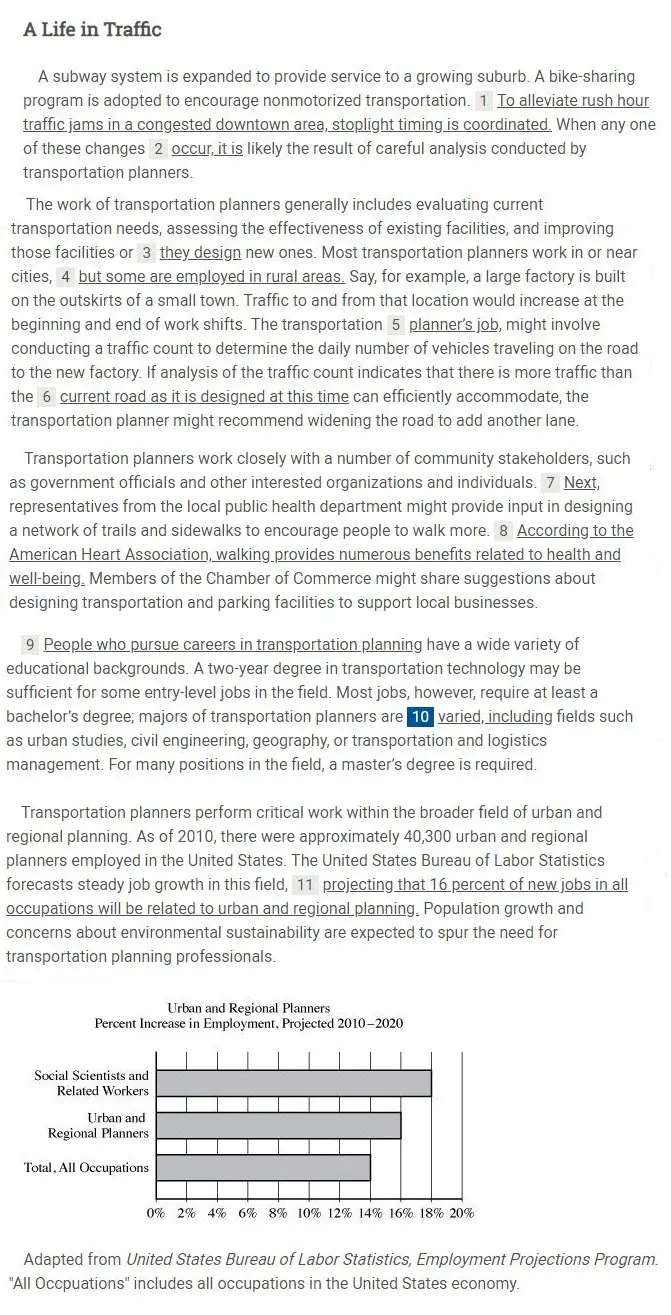
Choice A is the best answer because it uses a comma to effectively subordinate the list of varied fields in which transportation planners major. Choice B is not the best answer because the comma and coordinating conjunction “and” result in an ungrammatical sentence. Choice C is not the best answer because the coordinating conjunction “and” along with the subordinating conjunction “which” result in an ungrammatical sentence. Choice D is not the best answer because is it unclear from this construction to what exactly the subordinating conjunction “which” refers.